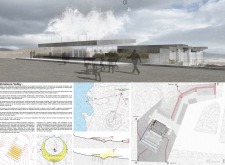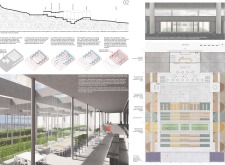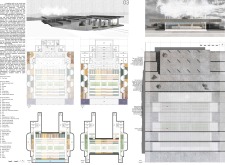5 key facts about this project
The Striations Valley architectural project is designed to integrate human activity with the natural landscape, reflecting the geological influences of the surrounding environment. Located in a valley characterized by glacial striations, the project aims to create a multi-functional space that supports culinary activities, greenhouse production, and educational programs focused on sustainable agriculture. The design emphasizes a connection to the natural topography while promoting practices that mitigate environmental impact.
Terraced Design and Spatial Organization
The project features a terraced configuration that adapts to the sloping site, minimizing excavation and preserving the integrity of the landscape. Each terrace is designated for specific functions, creating distinct zones for public interaction and agricultural activities. Key spaces within the project include a central greenhouse, educational galleries, and a restaurant, all designed to foster community engagement.
The greenhouse stands out as a pivotal element, featuring advanced climate control systems that utilize geothermal energy to maintain optimal conditions for plant growth. This integration of technology within the agricultural design showcases a commitment to sustainable practices. The careful arrangement of spaces promotes accessibility and encourages interaction among users, facilitating a comprehensive understanding of sustainable food production.
Sustainable Practices and Materiality
The project adopts a multifaceted approach to sustainability, incorporating low-carbon concrete for structural elements and maximizing the use of glass for natural lighting and ventilation. This choice of materials enhances the thermal performance of the building while creating visual connections to the landscape. Water conservation strategies, including rainwater harvesting, are incorporated to support irrigation needs within the greenhouse and gardens.
The design's innovative use of geothermal energy not only reduces reliance on non-renewable resources but also exemplifies practical applications of green technology in architecture. By focusing on these aspects, the Striations Valley project addresses contemporary concerns related to energy consumption and environmental stewardship while providing a functional space for community interaction.
For a more detailed understanding of the Striations Valley project, including architectural plans, sections, and design ideas, readers are encouraged to explore the project presentation for comprehensive insights into its architectural concepts and practical applications.






















































